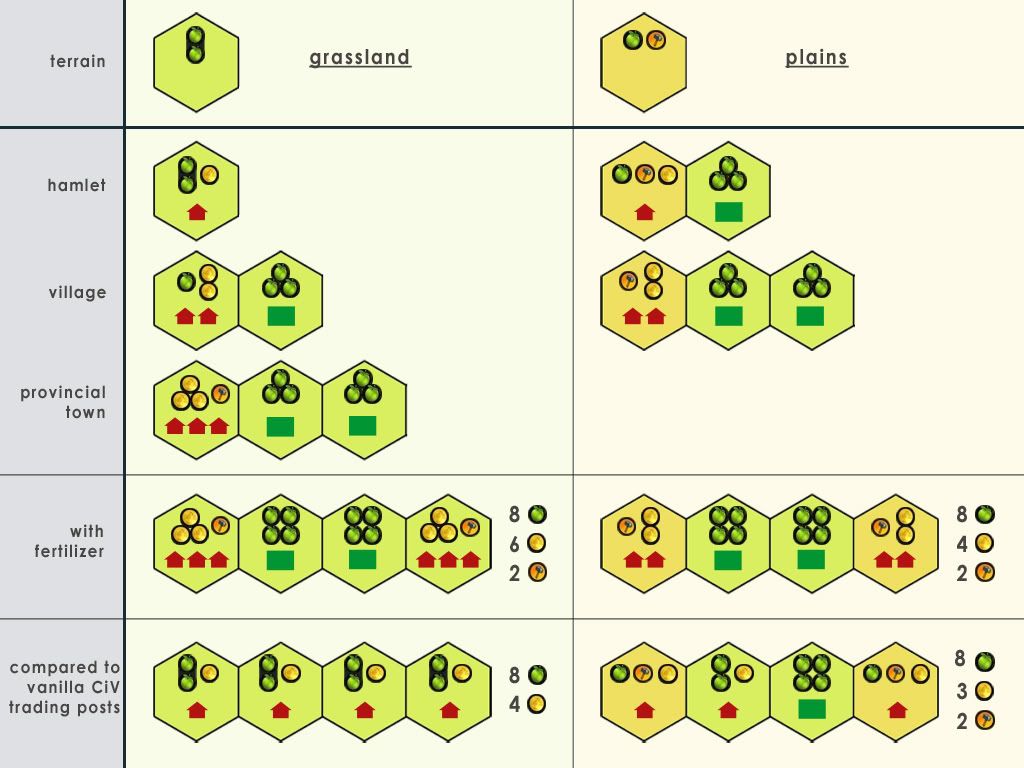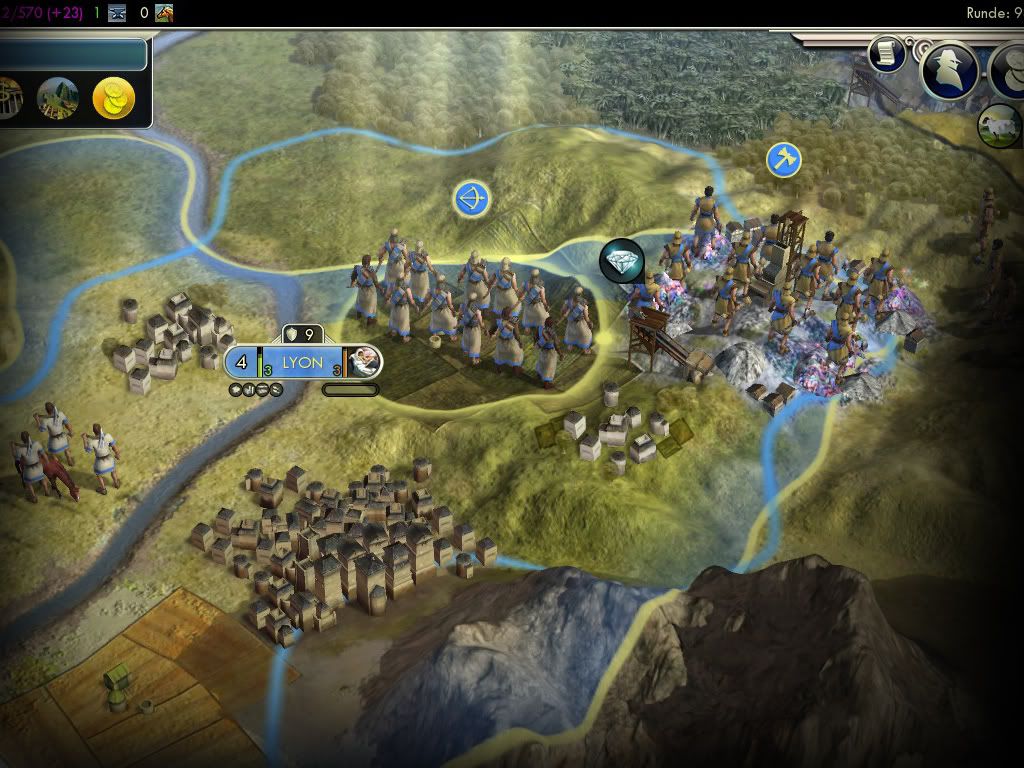3. Growing Settlements
3.1 General concept
- In “Thrive & Prosperity”, the trading post concept is replaced by growing settlements.
- Each settlement grows in three stages: hamlet → village → provincial town. The initial hamlet adds +1 and doesn't consume food (exactly like trading posts).
and doesn't consume food (exactly like trading posts).
- Growing has two effects:
a) the settlement must be worked over a certain time (50 turns).
b) the settlement must have surplus food on it's tile (see below).

Picture: Schemata of settlement growth (food neutral to main city)
3.2 Consequences
- In order to work a grown settlement without negative effects on the owning city's population, an additional farm is needed! A natural looking mix of small settlement and farms will develop, without the need of artificial restrictions and rules.
- Grassland will be way superior to plains concerning settlement growth. On plains, settlements may only reach 2nd size without further help.
- On hills settlements won't grow.
- Until the invention of fertilizer, settlement growth will be moderate. Population explosion is a modern phenomenon and will be represented in CiV by this concept. New buildings and SoPo's (see below) will accelerate this development.
- Rivers will be way more important, as they allow large settlements earlier in the game with “civil service”.
3.3 Visual representation
- A new graphical representation of trading posts was introduced in G&K. While this was a welcome change, another change is needed to represent growing settlements in T&P.
- Basically, settlements are smaller entities of the main city graphics. They are compose of small continent typical houses of a brighter colour, with some trees and small fields, to represent their self-sufficiency in smaller stages.

Picture: Lyon with provincial town (left) and village (right)
3.4 Interactions with the other game elements
- Some Social Policies will change, to interact properly with the new settlement system:
 , making further settlement growth possible. If settlement size reached provincial town-size already, supermarkets will make it possible to re-improve some farm tiles as settlements and stay food-neutral at the same time. (Representing population explosion and urbanisation!)
, making further settlement growth possible. If settlement size reached provincial town-size already, supermarkets will make it possible to re-improve some farm tiles as settlements and stay food-neutral at the same time. (Representing population explosion and urbanisation!)
BACK to main page
3.1 General concept
- In “Thrive & Prosperity”, the trading post concept is replaced by growing settlements.
- Each settlement grows in three stages: hamlet → village → provincial town. The initial hamlet adds +1
 and doesn't consume food (exactly like trading posts).
and doesn't consume food (exactly like trading posts). - Growing has two effects:
- +1
 ; additionally, provincial towns yield +1
; additionally, provincial towns yield +1  .
. - -1

a) the settlement must be worked over a certain time (50 turns).
b) the settlement must have surplus food on it's tile (see below).

Picture: Schemata of settlement growth (food neutral to main city)
3.2 Consequences
- In order to work a grown settlement without negative effects on the owning city's population, an additional farm is needed! A natural looking mix of small settlement and farms will develop, without the need of artificial restrictions and rules.
- Grassland will be way superior to plains concerning settlement growth. On plains, settlements may only reach 2nd size without further help.
- On hills settlements won't grow.
- Until the invention of fertilizer, settlement growth will be moderate. Population explosion is a modern phenomenon and will be represented in CiV by this concept. New buildings and SoPo's (see below) will accelerate this development.
- Rivers will be way more important, as they allow large settlements earlier in the game with “civil service”.
3.3 Visual representation
- A new graphical representation of trading posts was introduced in G&K. While this was a welcome change, another change is needed to represent growing settlements in T&P.
- Basically, settlements are smaller entities of the main city graphics. They are compose of small continent typical houses of a brighter colour, with some trees and small fields, to represent their self-sufficiency in smaller stages.

Picture: Lyon with provincial town (left) and village (right)
3.4 Interactions with the other game elements
- Some Social Policies will change, to interact properly with the new settlement system:
- “Free Thought” (Rationalism) will grant +1
 to hamlets, +2
to hamlets, +2  to villages and +4 (!)
to villages and +4 (!)  to provincial towns. This will compensate the fact that there will be less settlements, but more farms. Regarding provincial towns, it will actually be an *over*compensation to reward good settlement planing.
to provincial towns. This will compensate the fact that there will be less settlements, but more farms. Regarding provincial towns, it will actually be an *over*compensation to reward good settlement planing. - The Freedom-tree (starter, finisher or a policy) will affect settlement growth: If adopted, settlements will need only 25 turns (halved time) of being worked, to grow to the next bigger size.
- Interactions with other trees might be thinkable, too: “Communism” (Order) might lose it's +2
 per city and gain a +1
per city and gain a +1  per provincial town. A changed Commerce tree might grant an additional +1
per provincial town. A changed Commerce tree might grant an additional +1  per provincial town at some point.
per provincial town at some point.
 , making further settlement growth possible. If settlement size reached provincial town-size already, supermarkets will make it possible to re-improve some farm tiles as settlements and stay food-neutral at the same time. (Representing population explosion and urbanisation!)
, making further settlement growth possible. If settlement size reached provincial town-size already, supermarkets will make it possible to re-improve some farm tiles as settlements and stay food-neutral at the same time. (Representing population explosion and urbanisation!)BACK to main page
